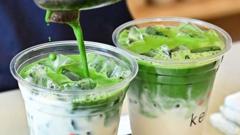The matcha phenomenon is on an unprecedented rise, with its vivid green hue making its way into countless food and drink products across the globe—from Starbucks lattes in the UK to Krispy Kreme doughnuts in Singapore. Social media platforms, especially TikTok, have significantly fueled this trend, generating millions of views under the "Matcha Tok" hashtag as influencers share recipes and brewing tips.
The newfound fascination with matcha aligns with a post-pandemic rejuvenation of tourism in Japan, where a weakened currency makes the country an appealing destination for international travelers, concomitantly boosting interest in Japanese goods, including its famed green tea.
However, this stratospheric demand is colliding with a tightening supply chain. Lauren Purvis, a tea importer based in the US, reveals that her clients are experiencing shocking shortages, with normally stable supplies vanishing in mere days. Some cafes now urgently request daily deliveries of a kilogram, highlighting the frantic pace at which retailers are trying to keep stock.
Matcha's traditional preparation involves a meticulous process deriving from ancient Japanese farming techniques. It is produced from specially grown green tea leaves termed tencha, which undergo a unique shading process to develop their characteristic umami flavor. Once harvested, these leaves are dried and ground using stone mills, normally able to yield around 40 grams of matcha per hour. Yet climate challenges—specifically record-breaking heatwaves in Japan—have compromised crop quality, impacting regional production primarily in Kyoto, the heart of matcha cultivation.
Additionally, Japan's aging farming population is exacerbating the crisis; there aren't enough younger individuals entering the industry to sustain production levels. Retailers in tea-centric locales like Uji, a city in Kyoto famous for its matcha, report swift depletion of inventory as eager tourists snap up available supplies, forcing many shops to restrict customer purchases to just one tin each.
As tea master Rie Takeda from Chazen, a Tokyo-based tea ceremony chain, outlines, the time taken for orders to arrive has significantly increased, spurring a nearly 30% uptick in matcha prices at her venues. Nonetheless, she remains optimistic about increased awareness of Japanese culture through this rise in demand.
Data from Japan's agricultural ministry underscores this flourishing market, with matcha production nearly tripling from 2010 to 2023 and green tea exports, including matcha, rising by 25% last year. However, this boom has led to a surge in mindful consumption advocates urging people to value high-grade matcha rather than hoard or exploit it for profit.
The Global Japanese Tea Association also stresses using lower-grade matcha that is more widely available for culinary purposes, emphasizing that high-grade varieties should be preserved for traditional uses.
Further complicating the situation, US tariffs imposed on Japan could lead to even higher prices for matcha enthusiasts, underscoring the urgency within the tea community to find solutions. As apprehension grows amongst distributors about the ramifications of recent trade dealings, some in the industry anticipate demand may stabilize within a few years, suggesting that while the matcha boom is currently in full swing, it may cool down as supply adjustments commence.






















